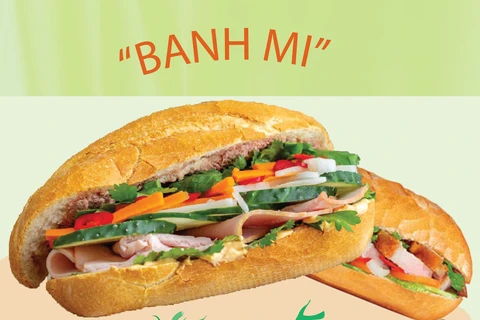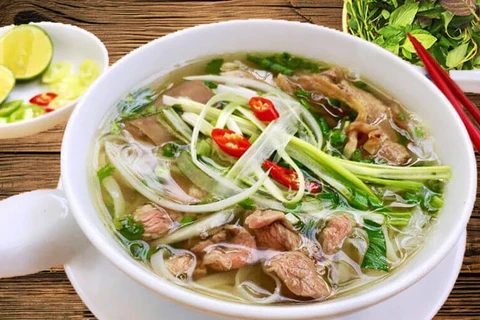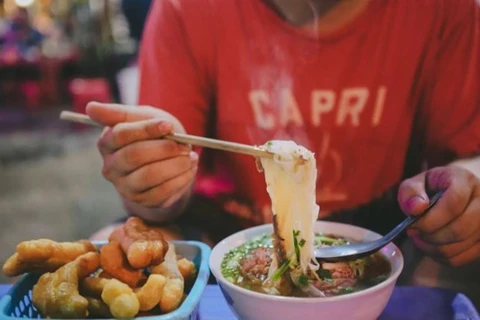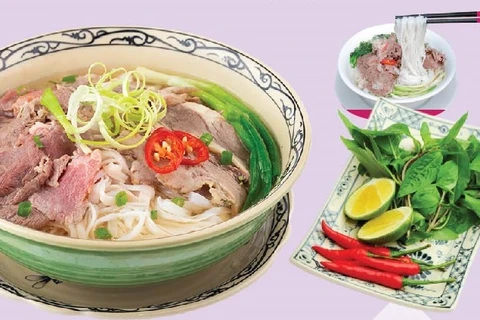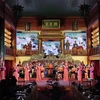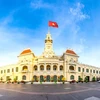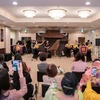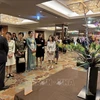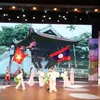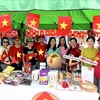 Although there are many places that sell Pho, Nam Dinh beef noodle soup always has a special flavour. (Photo: Vietnam Plus)
Although there are many places that sell Pho, Nam Dinh beef noodle soup always has a special flavour. (Photo: Vietnam Plus) Hanoi (VNA) – Located about 100km east of Hanoi capital, Nam Dinh province is known not only for its unique cultural heritage but also for local delicacies.
Pho bo (beef noodle soup) is a dish that has to be tried when visiting this locality. Although there are many places that sell it, Nam Dinh beef noodle soup always has a special flavour.
The name Pho Co (Co noodle soup) has always been mentioned by gourmet chefs when discussing Pho. It is not only a trademark of Nam Dinh, but it also refers to the origin of the dish and the Pho cooking profession. Van Cu village in Nam Truc district’s Dong Son commune - where most of villagers have the surname Co, is considered the birthplace of the Pho beef noodle soup dish.
According to 82-year-old Co Huu Trem, a local resident, in the old days, pho (noodle shop) was served without meat and in crab soup. Later chicken or pig bone broth was used.
The history of Pho begins at the end of the 19th century when Vietnam was under French colonial regime. The French’s demand led to a greater availability of beef in Vietnam. This in turn produced a surplus of beef bones, which were used by Chinese and Vietnamese Pho vendors to deepen and perfect the flavour of their broth.
In order to make a delicious bowl of Nam Dinh beef noodle soup, of course the broth cannot be ignored. This is an extremely important step and also an esoteric method of Pho makers. The sweeter and clearer the broth is, the more delicious the bowl of Pho becomes.
Noodles in Pho Nam Dinh are small and soft. To make delicious Pho, one must choose from seasonal rice, or rice from the previous crop.
Spices used for cooking pho, including star anise and cinnamon, must be obtained from the northwest region while fish sauce and salt are selected from Giao Thuy, Hai Hau, Nghia Hung districts of Nam Dinh. The careful selection of ingredients, spices and traditional cooking recipes create a noodle soup that is imbued with the cultural identity of Nam Dinh. This makes the noodle soup from this region different from Pho in other areas of Vietnam.
Van Cu village has a long-standing tradition of making fresh noodle and it is favoured by customers for its softness.
90-year-old Co Huu Kien said that in the past, each household can only make two quintals of noodles a day, adding that they were done manually. Now the amount of noodles produced can be up to ten times thanks to mechanisation.
According to Van Cu villagers, Cu Huu Vang is considered the person who pioneered selling noodle soup in Hanoi.
Following Vang’s footsteps, villagers have brought this dish to provinces and cities nationwide. At first, Pho was sold on the side of the road by street vendors, who wandered the city with a big pot of broth that always kept hot and ready with their mobile stoves. Then, when Pho became popular, successful street vendors opened restaurants.
After the country was re-unified, many Van Cu villagers left their hometown to do business. Many of them bring the pho cooking profession with them and have been successful.
Up to now, Van Cu villagers have opened nearly 100 noodle shops and 14 noodle production facilities across the country.
Co Long, owner of two noodle shops on Quan Nhan and Nguyen Tuan streets of Hanoi said every day his shops sell between 70 and 80kg of noodles a day, adding that Pho Nam Dinh is always appreciated by customers for its rich flavour, clear broth, and soft noodles.
In 2021, Nam Dinh's beef noodle soup was honoured among Top 100 Vietnamese specialties by the Vietnam Records Organisation. This is not only the pride of Nam Dinh people, contributing to economic development and local tourism, but also helps promote the cultural value of Nam Dinh noodle soup./.

